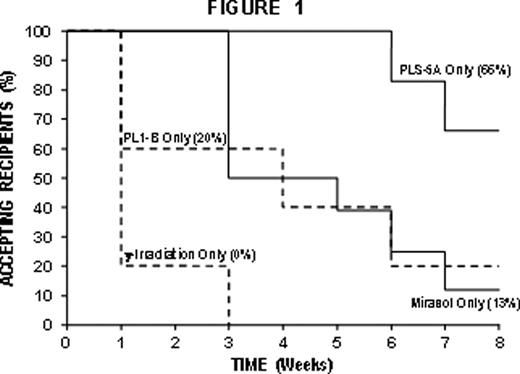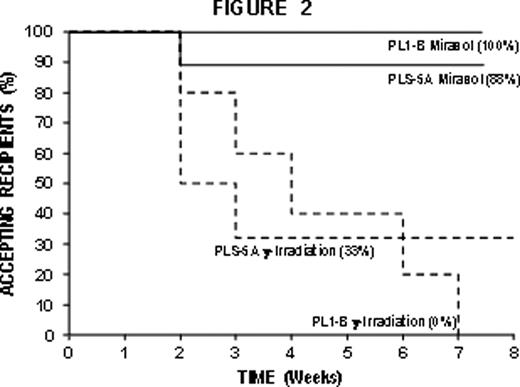Abstract
Abstract 3343
The TRAP Trial (NEJM 1997;337:1861) evaluated filtration leukocyte-reduction (F-LR) and UV-B irradiation (UV-BI) to prevent plt alloimmunization in AML patients (pts) receiving chemotherapy. Inclusion of UV-BI was based on a 45% rate of preventing plt alloimmunization in our dog plt tx model. UV-BI was 79% successful in the TRAP Trial. The lower success rate in the dog was probably because we use normal immunocompetent recipient dogs versus chemotherapy-induced immunosuppressed pts. The residual rate of alloimmunization in the TRAP Trial using either F-LR or UV-BI was still 17% to 21%, suggesting that better prevention methods are needed.
In our dog plt tx model, we evaluated two leukoreduction filters to remove antigen presenting WBCs (APCs) and γ-irradiation (γ-I) or UV-I combined with riboflavin (Mirasol pathogen reduction technology) to inactivate APCs. Crossmatch-negative, DLA-DRB incompatible donor/recipient pairs were used. Txs from the same donor were given weekly for up to 8 weeks or until the donor's 51Cr-labeled plts were rejected based on two sequential txs with donor plt recoveries ≤5% at 20 hours post-tx.
Residual WBC counts for standard, γ-l, or Mirasol-treated plts averaged 2,860/μl ± 1,800/μl, and, for F-LR plts using the PL1-B or the PLS-5A filter, they were 80/μl ± 10/μl and 110/μl ± 270/μl, respectively. Residual WBCs were significantly reduced after F-LR compared to non-leukoreduced plts (p<0.001), but there was no significant difference for WBC removal using either filter (p=0.86).
Except for the results with the PLS-5A filter, a single modification of the donor dog's plts is only minimally successful. Although residual WBC counts were similar for both filters, the better results achieved with the PLS-5A filter compared to the PL1-B filter (66% versus 20% success rate, respectively) suggest that the types of WBCs removed may be as important as simply a quantitative reduction in WBCs. Unfortunately, adding γ-l to F-LR did not improve the results using either filter. In contrast, Mirasol treatment markedly improved the results with both filters, suggesting that the effects of F-LR and Mirasol treatment are synergistic with F-LR removing APCs, while Mirasol treatment inactivates residual APCs. The effect is particularly striking for the PL1-B filter that is only minimally effective when used alone. The fact that a combined F-LR Mirasol treatment approach is so successful in our immunocompetent dog model using both good and poor performing filters may suggest two things: 1) the combined approach will be equally successful in both immunosuppressed as well as non-immunosuppressed pts; and 2) using any available leukoreduction filter combined with Mirasol treatment will give results similar to the two filters already tested. Based on our prior experience with UV-BI, data from our dog model may be directly transferable to man.
| Platelet Modification . | ⋕ Donors Accepted/⋕ Recipients (%) . |
|---|---|
| None | 1/7 (14%) |
| Single Modification: | |
| F-LR: | |
| Pall PL1-B Filter | 1/5 (20%) |
| Fenwal PLS-5A Filter | 4/6 (66%) |
| γ-l | 0/5 (0%) |
| Mirasol Treatment | 1/8 (13%) |
| Combined Modifications: | |
| F-LR plus γ-l: | |
| PL1-B Filter | 0/5 (0%) |
| PLS-5A Filter | 2/6 (33%) |
| Total* | 2/11 (18%) |
| F-LR plus Mirasol Treatment: | |
| PL1-B Filter | 6/6 (100%) |
| PLS-5A Filter | 7/8 (88%) |
| Total* | 13/14 (93%) |
| Platelet Modification . | ⋕ Donors Accepted/⋕ Recipients (%) . |
|---|---|
| None | 1/7 (14%) |
| Single Modification: | |
| F-LR: | |
| Pall PL1-B Filter | 1/5 (20%) |
| Fenwal PLS-5A Filter | 4/6 (66%) |
| γ-l | 0/5 (0%) |
| Mirasol Treatment | 1/8 (13%) |
| Combined Modifications: | |
| F-LR plus γ-l: | |
| PL1-B Filter | 0/5 (0%) |
| PLS-5A Filter | 2/6 (33%) |
| Total* | 2/11 (18%) |
| F-LR plus Mirasol Treatment: | |
| PL1-B Filter | 6/6 (100%) |
| PLS-5A Filter | 7/8 (88%) |
| Total* | 13/14 (93%) |
F-LR plus Mirasol-treated plts had a total success rate of 93% versus F-LR, γ-l plts at 18% (p=0.005).
shows the time to alloimmune plt refractoriness for recipients of single modified plts either F-LR, γ-I, or Mirasol-treated, while Figure 2 shows similar data for dogs who received F-LR plts combined with either γ-l or Mirasol treatment.
shows the time to alloimmune plt refractoriness for recipients of single modified plts either F-LR, γ-I, or Mirasol-treated, while Figure 2 shows similar data for dogs who received F-LR plts combined with either γ-l or Mirasol treatment.
Slichter:CaridianBCT Biotechnologies, LLC; Lakewood, CO: Research Funding; US Army Medical Research and Materiel Command/Dept of the Army – USAMRAA: Research Funding.
Author notes
Asterisk with author names denotes non-ASH members.



This feature is available to Subscribers Only
Sign In or Create an Account Close Modal